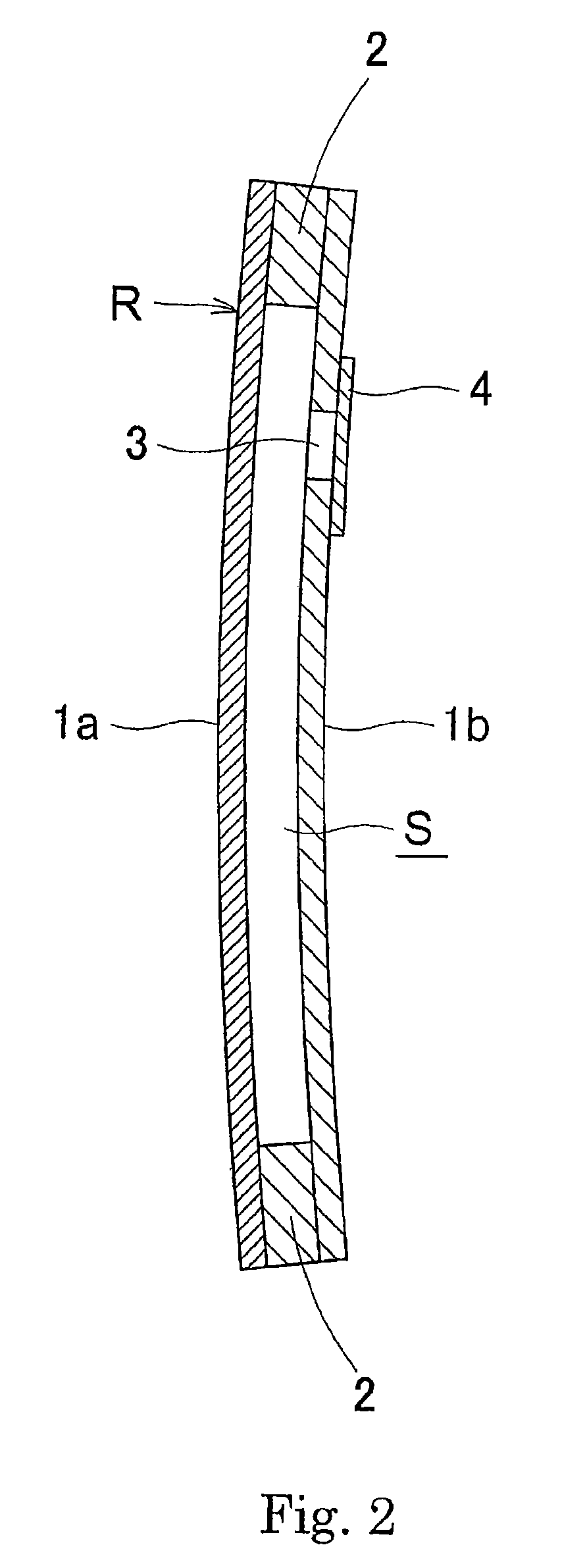Synthetic resin lens and eye lens article thereof
a technology of synthetic resin and eyeglasses, applied in the field of synthetic resin lenses, can solve the problems of limited heat generation of flexible materials, high material cost, and still develop fogging on the lens surface, so as to prevent the rise in the temperature of the wearer's skin, prevent the rise of the wearer's sweat, and reduce the effect of evaporation
- Summary
- Abstract
- Description
- Claims
- Application Information
AI Technical Summary
Benefits of technology
Problems solved by technology
Method used
Image
Examples
example 1
[0043]Ski goggles (double lens) were prepared with the synthetic resin lens of the present invention.
[0044]An outer lens 1a of the double lens member of the ski goggles was prepared as follows: 0.005 part by weight of an infrared absorber (IRG-022 produced by Nippon Kayaku Co., Ltd.) was mixed in 100 parts by weight of a polycarbonate resin S-2000 produced by Mitsubishi Gas Chemical Company, Inc.; in this mixture, 0.03 part by weight of a red dye (MLP Red-2, produced by Mitsui Chemicals, Inc.) having a function of absorbing blue or green was mixed for adjusting the transparency; the resultant mixture was extruded to obtain a 0.3 mm orangey sheet; to this sheet, a transparent sheet of 0.5 mm in thickness made of cyclopolyolefin resin having water absorption of 0.01% or less, produced by Japan Zeon Corporation, was bonded to obtain a multilayered sheet having a thickness of about 0.8 mm. The transmittance of visible light of this resultant multilayered sheet was about 50%, and the spe...
example 2
[0050]As an eye lens article of the present invention, a pair of goggles was prepared by using the synthetic resin lens of the present invention.
[0051]A lens 1 of this pair of goggles was prepared by mixing 0.008 part by weight of an infrared absorber (NIR-IM1 produced by Nagase ChemteX Corporation) in 100 parts by weight of a polycarbonate resin S-2000 produced by Mitsubishi Gas Chemical Corporation, Inc., and molding the resultant mixture.
[0052]The molded lens 1 had a thickness of 2 mm, a radius of curvature of about 87 mm, and about 55% transmittance of visible light. The lower limit of the spectral transmittance appeared in a near-infrared region of 1000 to 1200 nm and the spectral transmittance of the lower limit and thereabout was about 30%.
[0053]This lens 1 was cut into the shape of a lens of a pair of snow goggles. A surface of the lens 1 which, in the pair of the goggles, would became facing toward a wearer's face was coated with a film provided with a water-absorbing prope...
example 3
[0058]A shield, as the eye lens article of the present invention, was prepared by using the synthetic resin lens of the present invention.
[0059]A lens 1 of the shield which was prepared by mixing 0.008 part by weight of an infrared absorber (CIR 1081 produced by Japan Carlit Co., Ltd.) in 100 parts by weight of a polycarbonate resin S-2000 produced by Mitsubishi Gas Chemical Corporation, Inc., further mixing 0.02 part by weight of a red dye (MLP Red-2, produced by Mitsui Chemicals, Inc.) having a function of absorbing blue or green for adjusting the transparency, and molding the resultant mixture to make an orangey lens.
[0060]The molded lens had a thickness of 2 mm, a radius of curvature of about 87 mm, and about 54% of a transmittance of visible light. The spectral transmittance had a lower limit in a near-infrared region of 1000 to 1200 nm and the spectral transmittance of the lower limit and thereabouts was about 22%. Subsequently, the molded lens was cut into the shape for a shi...
PUM
| Property | Measurement | Unit |
|---|---|---|
| wavelengths | aaaaa | aaaaa |
| water absorption | aaaaa | aaaaa |
| spectral transmittance | aaaaa | aaaaa |
Abstract
Description
Claims
Application Information
 Login to View More
Login to View More - R&D
- Intellectual Property
- Life Sciences
- Materials
- Tech Scout
- Unparalleled Data Quality
- Higher Quality Content
- 60% Fewer Hallucinations
Browse by: Latest US Patents, China's latest patents, Technical Efficacy Thesaurus, Application Domain, Technology Topic, Popular Technical Reports.
© 2025 PatSnap. All rights reserved.Legal|Privacy policy|Modern Slavery Act Transparency Statement|Sitemap|About US| Contact US: help@patsnap.com



